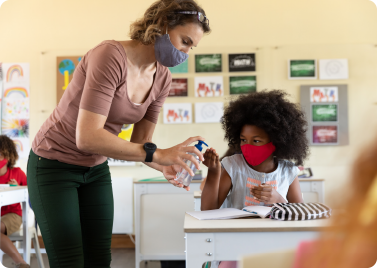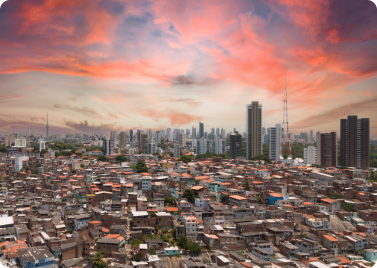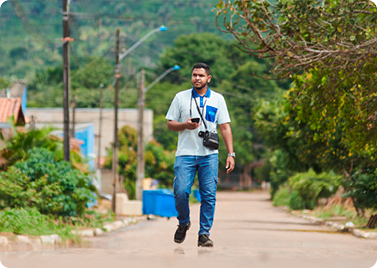Local community involvement based on participatory processes
More than the expansion of water supply and sewage treatment, our businesses have the potential to promote the socioeconomic development of the municipalities in which we are present. In the more than 100 cities we serve, our Private Social Investment (PSI) strategy contributes to sanitation being synonymous with growth and prosperity. Our corporate ambition is based on the concept of mobilizing society to exercise citizenship and the drive for sustainable development. Therefore, our strategy establishes standardized criteria and processes of allocation of financial resources and support to social projects, customized by the operational units (SPE) according to local vocations and potentialities.
One of the crucial elements of the PSI strategy are the mechanisms of consultation with key stakeholders, especially the local community. These processes aim to capture the main demands, needs, criticisms and suggestions of the local community serving as input for the design of programs and projects of social development of the communities and territories where we operate. At BRK, the implementation and monitoring of the PSI strategy, and with it the processes of consultation with the local community, fall under the responsibility of the Director of ESG, Sustainability and Risk Management. Also, in the operational units in all states where we have a presence, we have "sustainability focal points" that are professionals dedicated to the execution of the PSI strategy as well as the relationship with the community
In Table 1 we present the mechanisms of engagement, impact assessments and programs aimed at the local community
Table 1. Engagement operations, impact assessments, and development programs aimed at the local community [GRI 413-1]
| ACTION |
APPLICATION IN SPES¹ |
| |
2021 |
2022 |
| |
# SPES |
% |
# SPES |
% |
| Social impact assessments, including gender impact assessments, based on participatory processes |
22 |
100 |
22 |
100 |
| Environmental impact assessments and continuous monitoring |
22 |
100 |
22 |
100 |
| Public disclosure of the environmental and social impact assessments results |
0 |
0 |
0 |
0 |
| Development of programs based on the needs of local communities |
22 |
100 |
22 |
100 |
| Stakeholder engagement plans based on previous mapping of those local interested parties |
22 |
100 |
22 |
100 |
| Committees and broad consultation processes with the local community including vulnerable groups |
22 |
100 |
22 |
100 |
| Work councils, health and safety committees at work and other entities representing workers to discuss impacts |
22 |
100 |
22 |
100 |
| Formal complaints processes by local communities |
22 |
100 |
22 |
100 |
The follow-up details some of the actions mentioned in the table above.
¹Specific Purpose Societies. Brk's operating units are located in 13 Brazilian states: Araguaia (PA), Maranhão, Recife (PE), Maceió (AL), Jaguaribe (BA), Cachoeiro de Itapemirim (ES), Macaé (RJ), Rio das Ostras (RJ), Manso (MG), Rio de Janeiro (RJ), Limeira (SP), Santa Gertrudes (SP), Sumaré (SP), Mauá (SP), Uruguaiana (RS), Blumenau (SC), Caçador (SC), Mairinque (SP), Rio Claro (SP), Porto Ferreira (SP), Goiás (GO) and Saneatins (TO). The Capivari SPE provides leasing services preceded by the assignment of the right to use the construction of the collection subsystem and the removal and treatment of sewage from the Capivari river basin. Thus, this unit does not have direct operation of BRK nor, therefore, own allocated personnel.
Environmental and social impact assessments, including gender impact assessments, based on participatory processes and continuous monitoring
The assessment of environmental and social impacts is essential to prevent, mitigate, neutralize or even compensate for the potential negative effects of our operations on the environment and local community. Following this premise, BRK's internal procedures establish the system to identify the aspects and evaluate the environmental impacts of the processes, activities and services developed by the units, as well as the criteria to assess the significance of the impacts, aiming to establish environmental control measures to ensure the commitments of the QSSMA Policy , compliance with legal requirements and pollution prevention, stakeholders and the life cycle of our process. In addition to the environmental and social impact assessment procedure, we have other complementary normative instructions that, given the materiality for our business, require specific monitoring, control and mitigation actions. In Table 2 we describe some of these main procedures.
Table 2. Specific procedures for the assessment and monitoring of environmental impacts
| PROCEDURE |
DESCRIPTION |
| PR.006.COR.MAM: Fixed or mobile sources of atmospheric emissions and Management |
Monitoring and control of fixed or mobile atmospheric emission sources and the criteria for the adoption of mitigating measures related to the implementation works, expansion and operation and maintenance of water and/or sewage treatment systems |
| PR.003.COR.MAM: Chemical Management |
Minimum requirements for the management of chemical substances of the activities carried out in BRK’s actions, aiming at the protection of the health and safety of all employees and contractors, the environment and ensure compliance with legal requirements |
| PR.005.COR.MAM: Ambient noise and vibrations Management |
Monitoring and mitigation of environmental noise levels and vibrations resulting from construction activities, operation, and maintenance of systems, especially in urban and densely populated areas |
| PR.004.COR.MAM: Solid waste Management |
Integrated Solid Waste Management through a set of actions aimed at reducing the generation, disposal and proper disposal of waste, ensuring compliance with legal requirements |
| PR.008.COR.MAM: Investigation of environmental incidents |
Systematic to record, report, investigate and analyze environmental incidents, aiming at the establishment of corrective actions that prevent the occurrence of new similar cases |
| PR.002.COR.MAM: Environmental licensing process |
Environmental licensing process, including the obtaining and maintenance of licenses, environmental permits, and other authorizations that are necessary for the development of activities and compliance with legal requirements and in compliance with the restrictive environmental constrains of these documents |
In addition to the current processes of environmental and social impact assessment, BRK conducted, in partnership with the Brazilian Network of the Global Compact and the Trata Brasil Institute, the study "Women and Sanitation" aimed at the measurement of sanitation externalities on women. Based on official public data, the study quantifies the impacts of lack of sanitation on the life of Brazilian women in four aspects: health, education, income and well-being. The findings in this impact assessment study feed the social development strategy as well as the planning of operational interventions in the communities where we operate. In 2022, the study underwent updating and the complete material is available on the website: https://www.mulheresesaneamento.com
²Procedure No. PR.001.COR.MAM
³QSSMA: Quality, Health, Safety and Environment
Local development programs based on the needs of local communities and stakeholder engagement plans based on mapping of those local interested parties
The local projects and programs developed on our operational units follow the guiding principles and axes established in BRK's investment strategy and social performance. Social programs and projects are born from the guiding principles and axes, combined with local elements and needs captured in mechanisms of consultation with the local population. The main consultation mechanisms are: a) Door-to-Door Program; b) Social Duty; c) Social Diagnoses and d) Customer Satisfaction Survey.
The "Door to Door" Program takes place before BRK's sanitation works begin in the community. It is a field action where BRK agents visit the residents of a given neighborhood to explain about the arrival of the works, the economic and social benefits of sanitation and the main demands and doubts of the community.
The "Social Duty" usually occurs during the progress of sanitation works and aims to establish an open channel of dialogue with the population about the potential impacts of interventions and the benefits that access to sanitation can provide in the quality of life of residents.
“Social Diagnoses” are applied when the company wants to understand the needs and challenges of the community in order to co-build with local leaders social intervention models. Such intervention models are based on "Socio-Territorial Action Plans and Community Engagement" which include initiatives, projects and social programs to promote the participation and social insertion of families, contributing to the improvement of their quality of life and to the sustainability of the goods, equipment and services implemented. The effectiveness of such actions will take place to the extent that they are embraced by the local population, that is, if they are consistent with culture, desires and possibilities and even local limitations. The methodology for the elaboration of those plans and social diagnosis are detailed in the "Manual of Elaboration and Implementation of socio-environmental work project" that was implemented in all units.
The “Satisfaction Surveys” aim to understand the level of customer satisfaction with the services provided by BRK as well as the main points of improvement that need to be addressed by the company. The interviews are conducted by an independent research institute and the methodology encompasses quantitative and qualitative aspects. Throughout 2022, about 11,000 customers were interviewed and the main improvement points brought by customers are: lack and quality of water, return and sewage leakage, duration and impacts of the works. In Graph 1 we present the evolutionary series of the Customer Satisfaction Index (CSI) which is calculated from interviews with customers.

A clear example of internalization of the needs of local communities in the construction of social programs is Unicef's "Active School Search" project. In January 2022, UNICEF, with support from BRK, led a study in the State of Alagoas that found that 12,661 children had evacuated from the school system. Thus, this being an urgency and demand of the local community, BRK supported the project "Active School Search" whose objective will be to return about 3,500 students to the school network and train more than 700 education and social service professionals in the State to work on this front. Another example is the "Water Credit" project, led by the non-governmental organization "Water.org". The project offers low-cost credit to the population in need of financial resources to promote the connection of their home in the sewer system, build or renovate toilets and purchase water boxes. In this context, aiming to adapt the project to the needs of the population of the neighborhood of Torrões (Recife-PE), BRK hired a social diagnosis that pointed out the main social problems experienced by the community. This diagnosis brought together the official database survey, field interviews and dialogue wheels with the population. One of the items detected was that most of the residents who did not have access to treated sewage were unaware of the benefits of sanitation. At the same time, they suffered from a strong incidence of water-transmitting diseases and claimed to spend too much financial resources on chemicals to scare away insects and other vectors. Based on this finding, the project predicted dialogue wheels that showed how much they could save if they had sewage collected and treated in the neighborhood. Other elements pointed out by the community were included in the actions of the project.
For more details on the Local Development and Private Social Investment Programs, access the ESG Reports.

Work councils, health and safety committees at work and other entities representing workers to discuss impacts
At BRK we have some committees, implemented in the operational units, to discuss the issues of safety, health, and environment. These committees formed by the leadership and employees of various areas focused on the health promotion and the preservation of the safety of employees, contractors, and members of the public.
The actions developed by the committees include the identification of risks and implementation of security barriers, as well as the analysis of results of indicators and the proposition of actions for the continuous improvement of processes, controls, and governance of the unit.
The Health, Safety and Environment Commission (SSMA, abbreviation in Portuguese) is formed by the unit's director, operational and engineering manager, SSMA leader and other professionals who may be invited to participate eventually.
The meetings take place monthly to discuss the main proactive and reactive indicators of the area, the security incidents that occurred and the status of the action plans in progress, in addition to legal compliance through compliance with legal requirements and actions for the implementation or maintenance of the Security Management Program, among other relevant topics according to the pre-established agenda.
The CIPA (code for Internal Commission for Accident Prevention), consisting of officials elected and appointed by the company, aims to prevent incidents and diseases related to work, in order to make compatible work with the preservation of life and health promotion of the employee.
CIPA is responsible for monitoring the process of hazard identification and risk assessment as well as the adoption of prevention measures implemented, in addition to monitoring and monitoring the environments and working conditions and supporting the development and implementation of control measures for the identified risks, among other tasks.
The Ergonomics Committee (COERGO, abbreviation in Portuguese) is composed of professionals from various areas of the company, including CIPA and leadership. Among its functions, the main ones are to analyze work situations with ergonomic risks of harmful potential, develop studies of solutions to the ergonomic problems detected, instruct measures to promote improvement in the relationship of workers and their work and analyze the impact of new industrial and managerial technologies on workers. The goal of COERGO is to manage ergonomic risks in the workplace to neutralize or minimize them; in addition, it seeks to create the culture of ergonomics among workers. Today COERGO is implanted in 8 units (Cachoeiro de Itapemirim, Goiás, Jaguaribe, Macaé, Mauá, Rio das Ostras, Recife, and Saneatins).

Formal complaints processes by local communities
BRK has four main formal complaint mechanisms that can be accessed by local communities. The Confidential Channel is one of the main tools provided by the Compliance Program. The platform, available 24 hours a day, seven days a week, can be accessed by anyone and receives communications and reports ofcases that are in disagreement with our policies, values or legislation. The complainants can even make the communications anonymously if they wish. Those who identify themselves have guaranteed the confidentiality and confidentiality of their data. The reports are forwarded by the external company, manager of the Confidential Channel, and determined internally. In case of origin in the complaint, the legal and disciplinary measures to be taken are defined by the Ethics and Integrity Committee of the company. The second mechanism is the focal points of sustainability that are BRK professionals, crowded in all units, that perform diagnostic and dialogue actions with communities. BRK also has a Call Center available 24 hours a day, seven days a week, which receives and handles, in addition to the commercial and operational demands of customers, complaints and improvements in the quality of the service provided. Finally, the company also offers an online chat available on the website that can also be accessed at any time by the local community.














